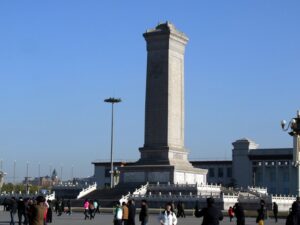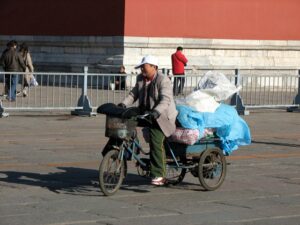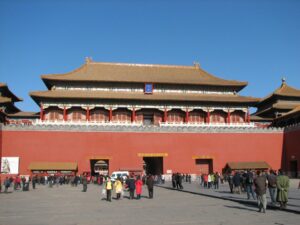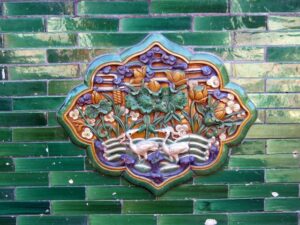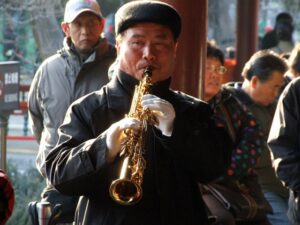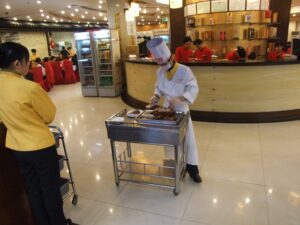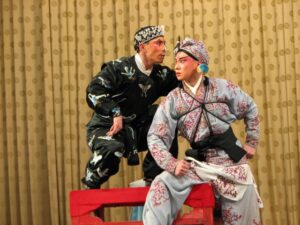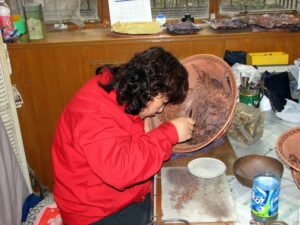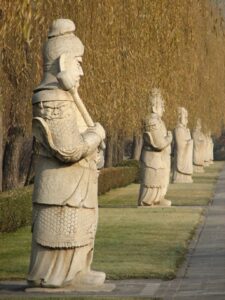Beijing is a city of sharp contrasts, with an ancient past coexisting alongside futuristic looking buildings and modern structures. We were very excited to visit this hip, happening city immediately prior to the 2008 Olympics, when the city’s inhabitants were giddy with delight at the prospect of finally being selected to host one of the world’s greatest sporting events. A contagious air of optimism permeated every corner of Beijing, and we were mesmerized by the leaps and bounds transformation that was evident throughout the city. Sights we were to experience included Tiananmen Square (the symbolic center of the Chinese universe), Forbidden City (the largest and best-preserved cluster of ancient buildings in China, that served as a fascinating backdrop to the drama that unfolded for 24 Ming and Qing Dynasties), the Temple of Heaven (a perfect example of Ming architecture where ancient heaven-worshiping ceremonies occurred), the Sacred Way and Ming Tombs, the Great Wall (the world’s largest military structure), and lastly, the Summer Palace (lavish playground for the Imperial court to escape from Beijing’s roasting summer scorch). We had a free morning to explore the BLCU on our own, and were able to solidify our desire to enroll in Chinese studies at the university at some point in the future. Overall, two thumbs up for Beijing, and we cannot wait to return here as “Beijingers” and call this city our home.
6 Dec 07: We had a late arrival into Beijing (2250) and were greeted by Izzy, our guide. She had been waiting patiently for us to show up, and immediately whisked us away to an underground garage. For the first time on our China trip, we had a compact sedan car (elsewhere in China, vans were the transportation mode of choice). This made for easy zooming around Beijing’s streets (although it wasn’t too crowded at 11 pm). It only took us thirty minutes to reach the Holiday Inn Central Plaza, which looked so inviting after “roughing” it in Lhasa for the past couple of days. The absolute first thing we did after checking into our room was take a HOT shower (yeah, celebration dance because of hot water), and wrapped ourselves up in the blissfully comfortable cotton bath robes hanging in the closet. What a great feeling! To be clean and warm again…and an extra bonus. Izzy told us tomorrow’s agenda wouldn’t start until 1030 am so we had a chance to sleep in! We were digging Beijing already.
7 Dec 07 Beijing: The Holiday Inn’s breakfast lounge had won several “best of Asia” awards and it was easy to see why. It had an excellent and wide spread of Western and Chinese dishes to choose from. We sat in the non smoking section to have our morning meal, and were pleasantly surprised when we saw that Izzy had also awoken early to have breakfast here. We departed the hotel at 1030 for a morning visit to Tiananmen Square and the Forbidden City. Izzy explained that we would be taking a one way trip this morning. The route would include walking across Tiananmen Square, entering the Forbidden City from its southern entrance, and exiting out the north where our driver would pick us back up. Since we weren’t going to be able to backtrack our steps, we stopped frequently for any photo ops that caught our eye.
Tiananmen Square literally means “Gate of Heavenly Peace”, and it is the world’s largest open urban square in the world at 880 by 500 meters or 108 acres. What an ironic name, considering our only impression of the square was filled with images of unarmed democracy-starved activists protesting in 1989. One image remains startling clear, with a single protester using his body to block an advancing column of tanks that appeared ready to roll over him! Today Tiananmen was filled with tour groups, aggressive souvenir hawkers, and Chinese paying respects at Mao’s Mausoleum. We walked over to the Tiananmen Gate, an ancient, massive gate that granted us access to the Forbidden City.
Despite the blisteringly cold temperature, the entrance to the Forbidden City was packed with visitors. Izzy informed us that the Forbidden City functioned as the Chinese Imperial Palace for the Emperor and his household from the middle of the Ming Dynasty until the end of the Qing Dynasty. For over 500 years, the city was completely off limits to everyone save the ruling Dynasty. Today, it stands as the marker for the middle of Beijing (all the ring roads encircle the Forbidden City), and houses the Palace Museum. Construction for the Forbidden City lasted 15 years (from 1406 – 1420), and the monstrous construction consisted of 980 buildings and 8,707 rooms spread out over 720,000 square meters. The last Emperor of China, Emperor Puyi, abdicated in 1912 and was allowed to remain with his family in the Inner Court of the Forbidden City. However, in 1924, Emperor Puyi was evicted during a coup, and the Forbidden City was immediately converted into a Palace Museum. Izzy described the rather sad story of “The Last Emperor” and recommended we watch the Bernardo Bertolucci film of the same name, as well as read “From Emperor to Citizen”, an autobiographical book of Puyi’s rise and fall. We wandered through numerous halls and courtyards, but unfortunately, much of the Forbidden City was undergoing a complete face lift. Perhaps in time for the 2008 Olympics? In any case, we did enjoy visiting but vowed to revisit again once the renovations were complete.
We lunched at a local restaurant called “Wa Ha Ha” where we had a surprisingly good leaf soup. The soup literally consisted of leaves and stalks, encased in a translucent gluey gel. We definitely would not have ordered this on our own, but were glad we gave it a try. Definitely something different that actually tasted pretty good. We also tried fried egg plant, pork, and fresh vegetables and enjoyed our meal here.
After lunch, we stopped at the Temple of Heaven Park, which is described as “the most perfect example of Ming architecture”. What a hubbub of activity! Chinese elders were playing musical instruments (senior citizens over 65 have free entrance to virtually every park, museum, etc), women were singing and dancing in front of an eager audience, and everyone was generally having a good time under the covered walkway leading up to the temple. The temples themselves were amazing. As seen from an aerial perspective, the temples are round and the bases are square, symbolizing the Chinese belief that the heaven is round and the earth is square. The most famous building is the “Hall of Prayer for Good Harvests”, and for good reason. It is considered architectural perfection: a triple gabled circular building that stands 32 meters wide and 38 meters tall, built entirely out of wood, and without a single nail to hold it in place! Easily the one icon that has come to symbolize Beijing, the image of this temple appears everywhere throughout China and beyond.
We headed back to the hotel for an hour’s rest before heading right back out again for an evening out on the town. Beijing duck was on our agenda, and we love roasted duck. Apparently fattened on soybeans and grain, the ducks are prepared in a special manner, with the end result a succulent treat. We were taken directly to the Qianmen Quanjude Roast Duck Restaurant, which is more commonly known as “Old Duck”, and it is Beijing’s oldest restaurant, circa 1864. Our waitress showed us the proper way to wrap our duck by placing a pancake flat on a plate, placing a piece of duck in the center, dipping a spring onion in either hoisin, peanut, or sesame sauce, and wrapping it altogether. Viola…Beijing duck at its best. What a feast! Post dinner, we headed over to the Liyan Theatre for a Beijing Opera show. It was pretty cool to watch the performers as they applied their face makeup and prepared for the show. We didn’t really know what to expect from the opera, but it was great and transcended all languages. There were small screens on either side of the stage providing English translations, but they weren’t really necessary as our attention was glued on the talented performers. Yup, today was a complete whirlwind of Beijing’s top “touristy” events, and we enjoyed every minute of it.
8 Dec 07 Beijing: Wonton soup for breakfast is a great meal to start the day. The wizened lady stirring the pot of soup spoke strictly Chinese, but somehow we both managed to get piping hot bowls of fresh wonton soup just the way we wanted it. Our 0900 excursion set out towards the Sacred Way and the Ming Tombs, but first we had a quick detour to the Changping “China Beijing North Suburb Industrial Art Factory”, where we watched a cloisonné demonstration. Little did we know when we purchased our cloisonné Christmas ornaments on the Yangtze River Cruise how much work goes into making this little pieces of art! After walking through the cloisonné workshops this morning, we had a newfound appreciation for this labor intensive product. For anyone who hasn’t a clue what cloisonné ware is, the demonstration is a must. We learned that this technique dates back to the Ming Dynasty, where blue enamel was chiefly used, hence the name “Chingtai Blue”. The cloisonné process involves vessels such as a vase, jar, bowl or plate that are used as base pieces. Layered on top of the base are pieces of copper that are formed and soldered together. The base is first measured with calipers, than manually marked for pattern placement. The pattern is carefully traced on the surface of the metal base. Cloisons are made with copper that is bent with pliers, following a pattern on paper. After dipping the bottom edge of the cloison in glue, it is placed onto the vessel with tweezers. The next step is to use eye droppers to fill the cloisons with enamel paste. After that is done, the entire piece is fired in an electric kiln. The heat causes the enamel to vitrify and settle into the cloisons. Three or four coats of enamel are applied and fired until the cloisons are completely full. The next to last step is to grind the enameled surface smooth with an electric lathe. Final polishing is done on a lathe, with water and charcoal. The last step is to electroplate the exposed copper with gold or silver. The final products are absolutely amazing, and we had no idea how much time and effort it took to create these masterpieces. Since we had already purchased our souvenirs on the cruise ship, we didn’t elect to buy anything from the workshop, although the selection was marvelous (with high end prices to boot).
Our next stop was at the Sacred Way, a 1 kilometer walkway “leading to heaven”. This divine road led to the imperial necropolis. The Chinese believe that the Emperor, also known as the “Son of the Heaven”, came from heaven to China through the sacred way. Of course the Emperor would return back to Heaven along the same road. Along the walkway, stone statues of 24 animals such as lions, camels, elephants, xiezhi/unicorn, as well as 12 human figures such as generals and civil officials were erected on either side of the road, facing each other. Supposedly, the animals flip flop positions at night! We entered the Sacred Way via a huge stone memorial archway. Inside the nearby Shengong Shengde Stele pavilion, a 50 ton turtle carries a massive stone inscribed tablet. The walkway was an easy stroll, and we excited out of the Dragon and Phoenix Gate. The underground Ming Tombs were a bit too far to walk from here, so we hopped in our car and drove over to the entrance. At present, only three (Chang Ling, Ding Ling, and Zhao Ling) of the 13 Ming Tombs have been excavated. Chang Ling Tomb is the largest, but only Ding Ling Tomb is open to the public.
What is unique about Ding Ling is that it is an underground mausoleum, buried 27 meters below the earth. This 4000 square meter palace was unearthed in two years, from 1956 to 1958. Ding Ling Mausoleum housed the 13th Ming Dynasty Emperor Zhu Yijun and his two Empresses. Izzy explained that originally only Zhu Yijun and one Empress was buried here, as the other woman was a concubine. As a concubine, she had no right to be buried next to the Emperor. However, the concubine’s grandson became an Emperor and ordered his grandmother’s body exhumed, elevated her to the status of “Empress”, and decreed that she be buried alongside Emperor Zhu Yijun. The entire underground palace is built out of marble, and is divided into five large chambers. The chambers display white marble coffin beds, intricately carved marble thrones, the Emperor and Empresses’ coffins, and blue porcelain jars (used for offerings in front of the thrones). The coffins remain covered, and apparently there are some rare artifacts displayed within the coffins (such as a golden Imperial crown). Izzy demonstrated how the massive portals to the chamber were originally opened (Chinese ingenuity), and we found the entire underground tomb complex quite interesting and worth a quick visit.
Sichuan food was served for lunch, alongside flower tea (the flower unfurled in the clear glass), and one flower provided sufficient flavor for several glasses of tea. Izzy asked us if we wanted to try to squeeze in a visit to the Summer Palace late this afternoon so we could have the entire morning tomorrow free to visit BLCU and we agreed to give it a whirl. This meant we’d have to rush around sightseeing at the Badaling Great Wall, but we were all for it. We’ve often heard that the Badaling Wall has a carnival like atmosphere, and that other sections of the Great Wall offer better views. Still, the distant image of Badaling raised our heartbeats, and we totally wanted to stop for photos at every angle.
On July 7, 2007 the Great Wall was listed as one of the 7 New Wonders of the World, and we can certainly see why. Prior to clambering up the wall, we had absolutely no idea how steep and tortuous it was. After we had spent 45 minutes hiking up the wall, T-shirt vendors popped out of nowhere hawking 20 Yuan t-shirts that appropriately stated “I climbed the Great Wall and Survived”…too funny! A brief history of the wall is that early in the Qin Dynasty, 221 – 206 BC, Qinshihuang (1st Emperor of Qin Dynasty), unified China and started construction of the wall to keep northern nomadic invaders out. During the Ming Dynasty, the original work was reinforced to defend against the barbaric Mongolian horde. The wall was created at 6 meters wide to allow up to 5 horses to simultaneously gallop along the top of the wall. There are numerous holes drilled on the wall to allow archers to shoot arrows against any invading army. Additionally, there were a series of signal fire platforms built all along the wall. These were used to send warning signals about the invading army’s strength. Smoke signal codes would indicate the size and strength of the enemy, and once one signal platform fired off a beacon, all others would follow suit so that everyone knew exactly how strong the invading force was. Apparently, Badaling Great Wall was the first part of the Great Wall opened to tourists, and today it remains as popular as ever. Despite the freezing cold temperatures, we sure did work up a sweat climbing the wall! Becky snagged 30 postcards for 10 Yuan (great bargains to be had on the wall), and begged off the other souvenir sellers as we didn’t want to lug around any heavy stuff. We can certainly attest to the physical conditioning of some of these souvenir sellers…they hiked up the steep sections of the wall just to try to earn a buck!
After heading back down to the car park area, we hopped in for a quick ride to the Summer Palace. The afternoon light was fading fast, and we wanted as much daylight as possible to see one of Beijing’s premier sights but it was not meant to be. Twilight was upon us as we entered into the Summer Palace. From what we could make out in the dark, the park complex was lovely and definitely warrants a visit during the daytime! Izzy explained that the Summer Palace complex is dominated by both Longevity Hill and Kunming Lake. The lake is completely artificial, and the excavated soil was used to create Longevity Hill! The Summer Palace served as a summer resort for Empress Dowager Cixi, the de facto leader of China for 40 years. It is alleged that she diverted all the silver designated for the Chinese navy into the reconstruction and enlargement of the Summer Palace. Empress Cixi is a fascinating character, described as a “devious despot who contributed in no small part to China’s slide into corruption, anarchy, and revolution…she used her power to accumulate vast quantities of money, bullion, antiques and jewelry, using the revenues of the state as her own. By the end of her reign she had amassed a huge personal fortune, stashing away some eight and half million pounds sterling in London banks. The lavish palaces, gardens and lakes built by Cixi were hugely extravagant at a time when China was verging on bankruptcy”. We were freezing by the time we had wandered all around the Summer Palace, so we headed back to our car to warm up and grab some dinner. Our evening meal was at the Chiang Nan mansion where we again had leaf soup, followed by a sweet orange pork dish, vegetables, and rice. We were the only tourists eating here. Even after almost three weeks in China, we were continually amazed at how fond Chinese are at eating out! Almost every restaurant we ate at in China was packed with Chinese enjoying a meal together. Maybe home cooking isn’t popular in China?
9 Dec 07 Beijing: BLCU here we come! Our last day in China was spent waking up early so we could scope out the campus facilities of our future school. First things first though…the Holiday Inn’s excellent breakfast buffet was calling so we stocked up on some food before hailing a cab. For a Sunday morning, traffic on Beijing’s roads was light, and it only took us twenty minutes to get to the university. The Beijing Language and Culture University (BLCU) is near the Wudaokou district on Xueyuanlu (Xueyuan Road), and Becky asked our taxi driver to point it out on our map so we had a rough idea of our overall orientation within Beijing. We spent the greater part of an hour checking out the classrooms, dormitories, and campus facilities. The gym offered various dance classes, yoga, aerobic and a swimming pool. Yup, you could stay we were stoked to be spending some time here in the future. The taxi ride back to the hotel was 35 Yuan (34 to get there) so our initial impressions on hopping a cab in Beijing is that they are fair, reliable, and friendly.
It was a gloomy, overcast day and the weather accurately reflected our mood as we mentally prepared ourselves that this was truly the end of our vacation. Izzy met us in the lobby and we had a brief lunch stop before heading to the Beijing airport. Checking in for our flight was a bit confusing. We initially (and mistakenly) thought we were flying from the Beijing Domestic terminal to the Shanghai Domestic airport (where we assumed we’d have to hop a cab to the international airport), but we were pleasantly surprised to find out our flight flew directly into the Pudong International airport. So no intercity transfer was necessary. We thanked Izzy and our driver for a great time in Beijing and promised to be in touch once we became “Beijingers”. The countdown for our return trip is on!

